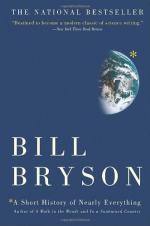|
This section contains 577 words (approx. 2 pages at 400 words per page) |

|
A Short History of Nearly Everything Summary & Study Guide Description
A Short History of Nearly Everything Summary & Study Guide includes comprehensive information and analysis to help you understand the book. This study guide contains the following sections:
This detailed literature summary also contains Topics for Discussion and a Free Quiz on A Short History of Nearly Everything by Bill Bryson.
For people over 30 years of age, science has changed a great deal since they were in school. New scientific theories, developments and discoveries abound that adults may be interested in learning about. However, how would one go about learning these things in an easy, simple way? Author Bill Bryson readily admits that he found science textbooks boring as a child, and his book, A Short History of Nearly Everything, is the successful result of his effort to produce a concise, readable, entertaining summary of current scientific thinking, for adults.
Each section within the book deals with one sphere of inquiry, such as outer space, the Earth, and living things. Each chapter explores a specific question such as "How did the Universe start?" or "What are supernovae and why are they important?" This is usually this is done by tracing the development of a thought or theory on a particular issue from its origin to the present. Along the way, Bryson illuminates the interesting and inspirational lives of key scientists and researchers.
Part 1 focuses on our universe and mankind's place in it. The first chapter details the Big Bang Theory, which suggests that the universe was formed in just a few brief moments. Two young astronomers, Arno Penzias and Robert Wilson, detected visible matter believed to be remnants of the Big Bang, and thus inadvertently discovered the evidence of this now-popular theory. Although they shared a Nobel Prize for their work, neither man realized the significance of their discovery until they read about it in The New York Times.
The size, shape, weight and orbit of the Earth are the focus of Part 2. In these chapters, Bryson profiles important geologists such as Henry Cavendish, who, in 1797, accurately measured the weight of the Earth using an apparatus so delicate that he had to peer at it with a telescope through a keyhole from an adjoining room. These chapters also detail Marie Curie's work with uranium, and explain why it was a European - not an American - who first described a dinosaur.
In Part 3, Bryson presents the theory of relativity and quantum physics as comprehensibly as possible. This section illuminates the flexible fabric of spacetime and the incredible amount of energy locked inside every molecule. It also attempts to explain the complex, static sub-atomic world, where nothing exists until it is observed, electrons travel from one spot to another without going through the intervening space, the universe is composed primarily of solid nothing, and particles travel faster than light.
The frightening revelations in Part 4 outline the dangers the Earth faces every day. These include being hit by one of the millions of meteors that cross the Earth's path two or three times per week; the potential eruption of the supervolcano at Yellowstone; a type of earthquake that can occur anywhere, any time; the ever-present and growing threat of global warming; and the history of ice ages and the possibility of their reoccurrence.
The final section deals with the topic of life on Earth. Life is amazingly abundant, and inexplicably lacking in diversity. Every living thing on Earth uses the same blueprint for life, suggesting a common ancestor somewhere in the dim, distant past. Bryson concludes by pointing out that humans are very lucky to be here. Over 90 percent of species that have lived on Earth since the dawn of time have become extinct - some by natural processes and others by way of mankind's ignorance.
Read more from the Study Guide
|
This section contains 577 words (approx. 2 pages at 400 words per page) |

|



